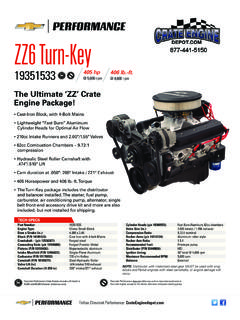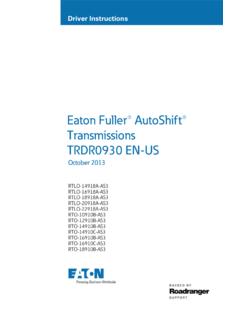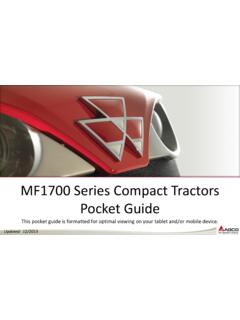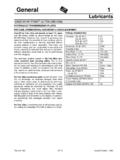Transcription of Oil Basics Typical Drivetrain Fluid Additives Gear Oil and ...
1 8 AMSOIL ACTION NEWS / MARCH 2006 gear Oil BasicsHigh quality gear oils must lubricate, cool and protectgeared systems. They must also carry damaging weardebris away from contact zones and muffle the sound ofgear operation. Commonly used in differential gears andstandard transmission applications in commercial andpassenger vehicles, as well as a variety of industrialmachinery, gear oils must offer extreme temperatureand pressure protection in order to prevent wear, pitting,spalling, scoring, scuffing and other types of damage thatresult in equipment failure and downtime. Protectionagainst oxidation, thermal degradation, rust, copper cor-rosion and foaming is also Oil and Motor Oil Are Not the SameGear oil differs from motor oil. Most people assume thatSAE 90 gear oil is much thicker than SAE 40 or 50 motoroil.
2 However, they are the same viscosity. According toAMSOIL Technical Drivetrain Products Manager KevinDinwiddie, the difference is in the Additives . Motor oil has to combat byproduct chemicals fromgasoline or diesel ignition and should contain additivessuch as detergents and dispersants, said Dinwiddie. Since an internal combustion engine has an oil pumpand lubricates the bearings with a hydrodynamic film, theneed for extreme pressure Additives such as those usedin gear oils does not exist in engines. Engine oils and gear oils both have anti-wear Additives ,and they both must lubricate, cool and protect compo-nents, but gear oils are placed under extreme amountsof pressure, creating a propensity for boundary lubrica-tion, a condition in which a full Fluid lubricating film is notpresent between two rubbing surfaces.
3 For example,differentials in cars and trucks have a ring and pinionhypoid gear set. A hypoid gear set can experienceboundary lubrication, pressures and sliding action thatcan wipe most of the lubricant off the gears. To combatthis extreme environment, extreme pressure Additives areincorporated into the oil. AMSOIL uses an extra treatmentof extreme pressure Additives in its gear oils in order toreduce wear and extend the gear and bearing DifferencesBecause many of the components found in the drivetrainconsist of ferrous material, the lubricant is required toprevent rust and possible corrosion to other and corrosion problems are not nearly as preva-lent in many small and intricate components thatmake up gear sets found in the Drivetrain can bequite noisy and may be subjected to shock viscosity and extreme pressure formulation ofgear oil quiets gears and dissipates shock loading.
4 The rotating motion of the gear sets also tends tochurn the lubricant, resulting in foaming. If a gear lubefoams, the load carrying capacity is significantly reducedbecause the air suspended within the oil is example, when the gear teeth come into contact witheach other any trapped air bubbles will compress, there-fore reducing the thickness of the separating oil film. Inturn, this reduction could lead to direct metal-to-metal con-tact between gear teeth and result in accelerated wear. Thegear oil must have the ability to dissipate this entrappedair, insuring a sufficient lubricating film exists to protect thegears from contact Drivetrain Fluid AdditivesMuch like engine oil, the chemical compounds, or addi-tives, added to Drivetrain base stocks either enhanceexisting properties or impart new ones.
5 Some of theadditives that may be found in a Drivetrain Fluid includethe following: Extreme pressure and/or antiwear agents - Theseadditives are used to minimize component wear inboundary lubrication situations. Pour point depressants - This type of additive isused to improve low temperature performance. Rust and corrosion inhibitors -These are used toprotect internal components. Oxidation inhibitors -These Additives are used toreduce the deteriorating effects of heat on the lubricant,increasing the lubricant s service life. Viscosity index improvers - These allow a lubri-cant to operate over a broader temperature range. Anti-foam agents - These are used to suppress thefoaming tendency and dissipate entrapped air. Friction modifiers -The required degree of frictionreduction can vary significantly between differing piecesof equipment in Drivetrain applications.
6 In some cases,friction modifiers may be required to obtain the Design Dictates Lube DesignGear designs vary depending on the requirements forrotation speed, degree of gear reduction and torqueloading. Transmissions commonly use spur gears, whilehypoid gear designs are usually employed as the maingearing in differentials. Common gear types include thefollowing:Maintaininga vehicle requires theuse of many lubricants,each specifically designed toperform a certain task or set oftasks. The most common lubri-cant requiring routine attentionfrom motorists is engine oil. Gearoil, on the other hand, is often-times overlooked when itcomes to scheduled ACTION NEWS / MARCH 2006 9gaging the gears, as is required in a manualtransmission. Instead, clutches and bandsare used to either hold or release differentmembers of the gear set to get the properdirection of rotation and/or gear gears differ from spur gears in thattheir teeth are not parallel to the shaft axis;they are cut in a helix or angle around thegear axis.
7 During rotation, parts of severalteeth may be in mesh at the same time,which reduces some of the loading charac-teristics of the standard spur gear . However,this style of gearing can produce thrustforces parallel to the axis of the gear minimize the effects, two helical gearswith teeth opposite each other are utilized,which helps to cancel the thrust out gears are an improvement over the doublehelical gear design. Both right and left hand cuts are usedon the same gear blank, which cancels out any thrustforces. Herringbone gears are capable of transmittinglarge amounts of horsepower and are frequently used inpower transmission differences in gear design create the need for sig-nificantly different lubrication designs. For instance,hypoid gears normally seen in automotive differentialsrequire GL-5 concentration and performance of extremepressure Additives .
8 This is because of the spiral sliding action that hypoidgears have, said differential applications that utilize hypoid gears,AMSOIL typically recommends one of the following:SEVERE gear Synthetic Extreme Pressure 75W-90(SVG), SEVERE gear Synthetic Extreme Pressure 75W-140 (SVO), SAE 80W-90 Synthetic gear Lube (AGL),Long Life Synthetic gear Lube SAE 75W-90 (FGR) orLong Life Synthetic gear Lube SAE 80W-140 (FGO)Most manual transmissions have helical gears and donot require GL-5 performance. The helical gear is almost a straight cut gear , but onan angle, said Dinwiddie. There is spiral action and verylittle sliding action, hence there is less need for extremepressure Additives . GL-4 gear lubes have half the extreme pressure addi-tives of GL-5 manual transmissions utlizing helical gears, AMSOIL typically recommends one of the following: SyntheticManual Synchromesh Transmission Fluid (MTF) orSynthetic Manual Transmission and Transaxle gear Lube(MTG).
9 AMSOIL Provides gear Oil OptionsAMSOIL carries Drivetrain lubricants to meet nearly everyapplication. The synthetic base stocks and top-qualityadditive packages found in AMSOIL gear lubes andtransmission fluids provide the ultimate in wear protec-tion for cars, trucks, outboards, heavy-duty and racingapplications. SpurSpur (straight cut) gears are widely used in parallel shaftapplications, such as transmissions, due to their lowcost and high efficiency. The design allows the entire geartooth to make contact with the tooth face at the sameinstant. As a result, this type of gearing tends to be sub-jected to high shock loading and uneven motion. Designlimitations include excessive noise and a significantamount of backlash during high-speed gears (straight and spiral cut) transmit motionbetween shafts that are at an angle to each found in various types of industrial equipment,as well as some automotive applications (differentials),they offer efficient operation and are easy to with spur gears, they are limited due to their noisyoperation at high speeds and are not the top choicewhere load carrying capacity is a gear sets employ a specially-machined worm that conforms to the arc of the driven gear .
10 This type ofdesign increases torque throughput, improves accuracyand extends operating life. Primarily used to transmitpower through non-intersecting shafts, this style of gearis frequently found in gear reduction boxes as it offersquiet operation and high ratios (as high as 100:1).Downfalls with this type of gear set are its efficiency, highprice per HP and low ratios (5:1 minimum).HypoidHypoid gear sets are a form of bevel gear , but offerimproved efficiency and higher ratios over traditionalstraight bevel gears. Commonly found in axle differentials,hypoid gears are used to transmit power from the driv-eline to the axle gear sets, such as those found in automatictransmissions, provide the different gear ratios neededto propel a vehicle in the desired direction at the correctspeed. gear teeth remain in constant mesh, which allowsgear changes to be made without engaging or disen-8 AMSOIL ACTION NEWS / APRIL 2006 Motorists know when they re supposed to change theirmotor oil.







